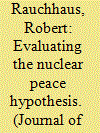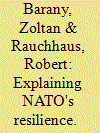| Srl | Item |
| 1 |
ID:
087448


|
|
|
|
|
| Publication |
2009.
|
| Summary/Abstract |
Do nuclear weapons reduce the probability of war? This article quantitatively evaluates the nuclear peace hypothesis. The results indicate that the impact of nuclear weapons is more complicated than is conventionally appreciated. Both proliferation optimists and pessimists find confirmation of some of their key claims. When a nuclear asymmetry exists between two states, there is a greater chance of militarized disputes and war. In contrast, when there is symmetry and both states possess nuclear weapons, then the odds of war precipitously drop. When combined, these findings provide support for the existence of the stability-instability paradox. Evidence suggests that while nuclear weapons promote strategic stability, they simultaneously allow for more risk-taking in lower intensity disputes.
|
|
|
|
|
|
|
|
|
|
|
|
|
|
|
|
| 2 |
ID:
106768


|
|
|
|
|
| Publication |
2011.
|
| Summary/Abstract |
Over the past two decades, NATO's membership and mission have expanded. Practitioners and scholars have extensively debated the pros and cons of the changes, but few have sought to explain why the alliance is so resilient. This paper directly asks and answers the question: Why has NATO mission and membership expanded since the end of the Cold War? Three leading approaches of international relations are used to answer this question. The empirical analysis finds that in isolation, none of the theories perform well at predicting or explaining NATO's adaptation to the post-Cold War environment. However, when combined, they do offer a coherent explanation for the alliance's enlargement and the development of out-of-area operations.
|
|
|
|
|
|
|
|
|
|
|
|
|
|
|
|